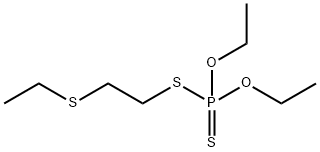CHEMICAL AND PHYSICAL PROPERTIES
| Physical Description | Disulfoton is a dark, yellow, oily liquid with a characteristic sulfur odor. It is a water emulsifiable liquid. It is toxic by inhalation, skin absorption, and/or ingestion. Exposure to skin or eyes may cause burns. It is combustible but does not ignite easily. When exposed to high temperature this material may emit toxic fumes. It is used as a pesticide. May be found in the form of a dry mixture where the liquid is absorbed onto a dry carrier. |
|---|---|
| Color/Form | Pure compound: yellow liquid |
| Odor | Characteristic, sulfur odor. |
| Boiling Point | 270 to 271 °F at 1.5 mmHg (EPA, 1998) |
| Melting Point | Greater than -13 °F (EPA, 1998) |
| Flash Point | greater than 180 °F (NIOSH, 2023) |
| Solubility | 0.003 % at 73 °F (NIOSH, 2023) |
| Density | 1.144 (EPA, 1998) - Denser than water; will sink |
| Vapor Pressure | 0.00018 mmHg at 68 °F (EPA, 1998) |
| LogP | log Kow = 4.02 |
| Stability/Shelf Life | OXIDIZABLE IN AIR /SRP: TO SULFOXIDES, SULFOXONES AND THEIR OXONES/. |
| Decomposition | /Decomposition half-life/ (22 °C) 133 days (pH 4), 169 days (pH 7), 131 days (pH 9). Photolysis DT50 1-4 days. |
| Refractive Index | Index of refraction: 1.5348 for 20 °C and sodium light |
| Kovats Retention Index | 1762 1780 1783 1776 1774.5 1753 1775.3 1782.4 1790 1790 1781.8 1782.8 1783.5 1772.9 1789.7 |
| Other Experimental Properties | SUSCEPTIBLE TO ALKALINE HYDROLYSIS |
| Chemical Classes | Pesticides -> Organophosphate Insecticides |
SAFETY INFORMATION
| Signal word | Danger |
|---|---|
| Pictogram(s) |
 Skull and Crossbones Acute Toxicity GHS06  Environment GHS09 |
| GHS Hazard Statements |
H410:Hazardous to the aquatic environment, long-term hazard |
| Precautionary Statement Codes |
P262:Do not get in eyes, on skin, or on clothing. P264:Wash hands thoroughly after handling. P264:Wash skin thouroughly after handling. P273:Avoid release to the environment. P280:Wear protective gloves/protective clothing/eye protection/face protection. P301+P310:IF SWALLOWED: Immediately call a POISON CENTER or doctor/physician. |
COMPUTED DESCRIPTORS
| Molecular Weight | 274.4 g/mol |
|---|---|
| XLogP3 | 4 |
| Hydrogen Bond Donor Count | 0 |
| Hydrogen Bond Acceptor Count | 5 |
| Rotatable Bond Count | 9 |
| Exact Mass | 274.02848036 g/mol |
| Monoisotopic Mass | 274.02848036 g/mol |
| Topological Polar Surface Area | 101 Ų |
| Heavy Atom Count | 14 |
| Formal Charge | 0 |
| Complexity | 168 |
| Isotope Atom Count | 0 |
| Defined Atom Stereocenter Count | 0 |
| Undefined Atom Stereocenter Count | 0 |
| Defined Bond Stereocenter Count | 0 |
| Undefined Bond Stereocenter Count | 0 |
| Covalently-Bonded Unit Count | 1 |
| Compound Is Canonicalized | Yes |
PRODUCT INTRODUCTION
description
Disulfoton is a manufactured substance used as a pesticide to control a variety of harmful pests that attack many field and vegetable crops. It does not occur naturally. Pure disulfoton is a colorless oil with an unidentifiable characteristic odor and taste. The technical product is dark yellowish, with an aromatic odor. Common trade names are Di-syston, Disystox, Frumin AL, and Soilvirex. Use of trade names is for identification only and does not imply endorsement by the Agency for Toxic Substances and Disease Registry, the Public Health Service, or the U.S. Department of Health and Human Services. It is used to protect small grains, sorghum, corn, and other field crops; some vegetables, fruit, and nut crops; and ornamental and potted plants against certain insects. Although it is used mostly in agriculture, small quantities are used on home and garden plants, and for mosquito control in swamps. The use of disulfoton has decreased in recent years.

